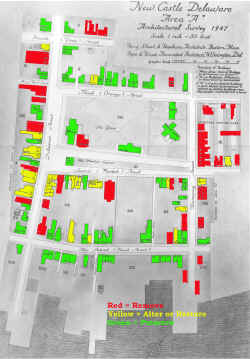Williamsburg on the Delaware
Image courtesy New Castle Historical Society
(Click to enlarge)
Many residents of New Castle have heard that there was
once a plan to radically change the town and restore it with the help of J. D.
Rockefeller in the fashion of
Williamsburg. Only an outraged populace prevented this from occurring.
While elements of the story are correct, it did not quite unfold in this
fashion. Some details are available at the NCHS exhibit "Before
we were historic" at the Old Library, others in an article by Deborah Van
Riper Harper and available as a
.pdf ( 2 MB) . This article was originally published in Delaware History 25
(1992-93): 77-105 and is posted here with permission of the Historical
Society of Delaware (www.hsd.org).
The
map at left shows the plan proposed in 1947 by the Boston architectural firm of
Perry, Shaw and Hepburn. The color code is: red-remove, yellow-alter,
green-preserve. Clearly much of the town would be modified or
removed. -- almost all of the buildings on Harmony and Delaware Streets and most
of those on the south side of 2nd.
This firm, which had been the architects for the Williamsburg
reconstruction, had been hired by Historic Research Inc., later Historic New Castle Inc., a group largely
consisting of one man, Col. Daniel Moore Bates. As detailed in the Harper
article Bates had been interested in preserving New Castle, and in 1934
had contacted "Rev. W. A. R. Goodwin, the Virginia Clergyman who had
captured Rockefeller's interest for Williamsburg, to inform him of the
possibilities of New Castle. Goodwin wrote back at length. Already personally
familiar with New Castle, he shared Bates's enthusiasm for its potential, but
raised an issue that was to plague all of Bates's efforts: New Castle had no
Rockefeller.
After WWII, research on individual houses and plot ownership was carried out for the company by local historian Jeannette Eckman, and Bates provided funds for the drawing of the project plans. These were presented at a public meeting in 1947 presided over by local historian Judge Richard Rodney. "In general, the response to the presentation was overwhelmingly positive. Bates received many glowing letters, and favorable reviews appeared in the local and Wilmington papers. In the following weeks, only one letter appeared in the New Castle Gazette questioning the wisdom of the proposal.
But, in the end, Bates did not find a financial backer for the project and had to abandon it. He was instrumental or influential in establishing zoning protection for the historic area, the renovation of the Courthouse, and transformation of the Victorian Presbyterian Church to its current colonial revival form.
Harper wrote "Today most of New Castle's architectural gems from all time periods remain more or less intact, but support for preservation is not universal. Some residents still consider Victorian buildings unworthy of special consideration. They chafe at the restrictions that come with living in the historic district and would have them lifted on houses dating from the post-colonial era. Several Victorian-era buildings have been demolished, some quite recently, and replaced with bland pseudo-colonial structures or with mini-parks that leave telling gaps in the streetscapes. Other buildings are threatened. Yet many residents take pride in the city's diverse architectural heritage. Nicholas McIntire often wrote in the NewCastle Gazette about the annual "Day in Old New Castle" celebration,fondly calling it "Colonial Day," but that term is inappropriate today, when restored Victorian homes are also proudly displayed to the visiting public.
It was largely for the "visiting public" that Daniel Moore Bates and his associates sought to preserve New Castle. Their motives were admirable by the preservation standards of their day, for they truly believed that they were performing a service to the American people, one that wouldfoster a sense of patriotism while providing a stabilizing influence in a rapidly changing world. Yet the real credit for the town one sees today lies with the residents, who, while inspired by the early preservationists, ultimately demonstrated a broader vision. They see New Castle not as a relic from the past, but as a vibrant community whose story continues to unfold, and choose to protect it not as a museum, but because it is their home.
"
Jim Meek, nc-chap.org
Oct. 2006
Oct. 2006